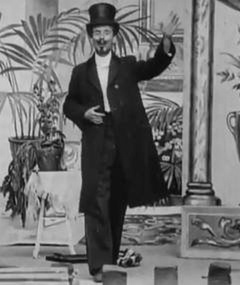Most commonly cited as the first horror movie is The Haunted Castle (Le Manoir du diable in French), a short by influential French filmmaker Georges Méliès. Due to his innovations in special effects and filming techniques, he was easily one of the most important early filmmakers. Méliès was more well-known for making some of the first science fiction shorts, including A Trip to the Moon and The Impossible Voyage.
The Haunted Castle was released in 1896, only eight years after the first film was made. The three-minute short starts off with a bat transforming into a human in front of the audience's eyes, basically making it the first vampire flick as well.
This was pulled off with Méliès' famous substitution splice trick where he would carefully match up two frames in order to give the illusion that one thing had instantly changed into another. The devil then performs various other tricks and appears in different forms using the same film splicing method.
It was thought to be lost until 1988 when a copy luckily surfaced in New Zealand.
In 1897, the following year, the Méliès short was remade. Still called The Haunted Castle, this one was made by the influential British filmmaker George Albert Smith, who developed Kinemacolor, the first working color film process. Smith served as producer, writer, director, and camera operator.
The minute-long short is about an inn run by ghosts, making it one of, if not the earliest ghost-themed films, as well as the first British horror movie.
The inspiration from Méliès is obvious as it makes liberal use of the substitution splice trick. The two filmmakers eventually worked together on the 1902 film The Coronation of Edward VII.
Also in 1897, there was another Méliès work that could fall under the umbrella of horror. The Bewitched Inn is about a man (played by Méliès himself) discovering a hotel room that has magical properties. Furniture disappears, a candle explodes when it is lit, and objects move of their own accord.
According to Wikipedia, this "is the first known Méliès film to feature inanimate objects coming to life to tease their owners, a theme that would return time and again throughout his work." Of course, Méliès' trademark splice trick shows up a few times to sell the idea of a magical room. This is all played more for laughs as opposed to trying to scare the audience.
The Bewitched Inn clocks in at under two minutes and was made by Méliès' Star Film Company.
In 1898, George Albert Smith pops up again as the director behind Photographing a Ghost. As the title suggests, it is about an attempt to take a picture of a ghost, which doesn't end up going so well.
Unfortunately, I can't find this anywhere online, and it appears to be lost. However, we do have a surviving description from the Edison Company. According to the summary, the short begins with two men carrying a case with the word "Ghost" written on it. A photographer opens it up and a "tall, white Thing" comes out. Eventually, the man tries to sit on the trunk to keep the ghost out, but when he turns around, he sees the ghost right behind him.
 |
| George Albert Smith |
Also in 1898 is what appears to be the first American horror film, The Cavalier's Dream. It was directed by a very important figure in film history, Edwin S. Porter.
Porter is mostly known for making the 1903 film The Great Train Robbery, which is indisputably one of the most important works of the silent era. It influenced many followers largely because of its use of crosscutting, where events in two separate locations are happening simultaneously. The film cuts between them to show they are happening at the same time.
Like Photographing a Ghost, The Cavalier's Dream sadly seems to be lost and we only have an Edison Company description to go by. Said description indicates the short features Mephistopheles and an old witch who transforms into a beautiful young girl.
 |
| Edwin S. Porter |
Moving on to 1899, there's another British horror film. This one is called The Miser's Doom and was directed by Walter R. Booth, who made some of the earliest science fiction films, such as 1909's The Airship Destroyer and the 1910 film The Aerial Submarine.
This film is also lost, but we do know it featured a ghost.
 |
| Walter R. Booth |
Finally, we come to two more Méliès horror films, with these being released in 1899. The only surviving one of the two is The Devil in a Convent. It featured a devil (played by Méliès) causing chaos in a convent and was seen as a satire of Catholicism. A priest actually turns into the devil, so it makes sense that it was viewed as satirizing the church.
The other is Robbing Cleopatra's Tomb, which is lost. The plot centers on an attempt to resurrect Cleopatra's mummy. In 2005, it was claimed that a copy of this film was found, but it turned out to be another movie entirely.
Please follow me on Facebook or on Twitter @KinoPravdaBlog. I'm also on Instagram as lordofthewalri.
No comments:
Post a Comment